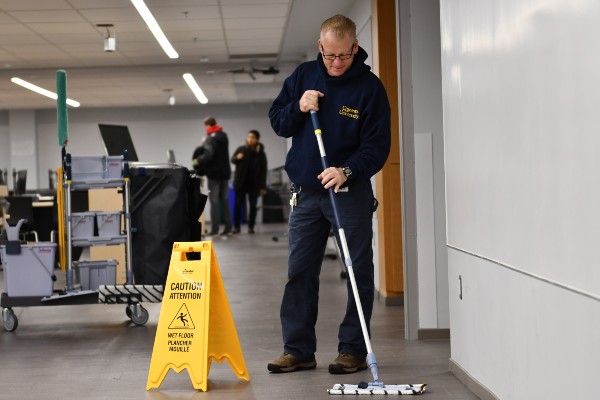Cleaning goes green on campus
December 10, 2019
Share

Every day, thousands of people are on the Queen’s campus working and studying, as well as living in the student residences. All this activity creates a few big challenges for the university. Among them is the need to keep things safe and clean, while also maintaining a commitment to sustainability.
To promote cleanliness and sustainability simultaneously, Queen’s is now working towards fully adopting green cleaning practices. This transition is coming about through several connected changes in the Custodial Services team. Most significantly, they are adopting certified green cleaning products, reusable microfiber cloths, and will no longer use hot water in cleaning. Already implemented in a few buildings on the campus, these new approaches are expected to be in use across the campus in 2020. On top of improving the sustainability of the university, these changes are also expected to raise the standards of cleanliness on campus.
“Creating a culture of sustainability at Queen's means we must strive to embed sustainability into all aspects of the university. It is wonderful to see our leadership team in Custodial Services taking the initiative to provide environmentally friendly cleaning options for our campus,” says Donna Janiec, Vice-Principal (Finance and Administration).
The adoption of certified green cleaning products will help Queen’s reduce its use of chemicals without sacrificing standards for clean spaces. Once they have fully transitioned to environmentally-friendly cleaning, the Custodial Services team will exclusively use products that have been certified as Green Guard Gold by Underwriters Laboratories, an organization that evaluates the environmental friendliness and effectiveness of cleaning products through rigorous testing. Green Guard Gold cleaners are those that have been found to improve indoor air quality (which means they contain no volatile organic compounds) while also having low chemical emissions.
“These new cleaning products are being sourced from a Canadian company, and they are rated to provide the highest standards of efficacy, cleanliness and sustainability. Once we’ve finished transitioning to using these products across the university, our campus will be both cleaner and greener,” says Samuel Whyte, Director, Quality and Service Excellence (Custodial) in Physical Plant Services.
Reducing waste
These cleaners also minimize waste by making it easy to adjust the dilution of the cleaning liquid. Many of the green cleaning products are applied through a dispenser that mixes the product with cold water. Cleaning staff can change the amount of product that they mix with the water depending on the job they are doing. For instance, there are distinct recommended settings for cleaning glass, carpets, and washroom surfaces to ensure that cleaning staff use only the necessary amount of cleaning product in their work, greatly reducing the number of single-use containers used in cleaning.
The fact that the cleaning products are all effective when used with cold water will help to significantly reduce the amount of hot water used. This could translate into a reduction in the amount of energy the university uses. Custodial Services is also reducing waste through the adoption of reusable microfiber cleaning cloths, which will replace the use of paper towels in 2020.
New colour-coded cleaning system
These cleaning supplies will be utilized through a new systemized cleaning process that is being implemented in conjunction with the green cleaning products. Custodial Services will now be using a colour-coded system to organize which teams clean which areas of a building and what supplies they use.
In this new system, different types of areas are given a specific colour code. For instance, student learning areas, such as classrooms and libraries, are given the colour code of yellow. These spaces will be cleaned only with yellow microfiber cloths and other cleaning instruments, like mops, that are marked yellow. Similarly, public and common areas are coded green, staff areas are coded blue, and washrooms and changing areas are coded red. Different teams of cleaners will specialize in cleaning different types of areas. Using the same products and teams for similar spaces helps prevent cross contamination and increases efficiency.
“Over the past few years, we have witnessed Queen’s take strides towards making our campus more sustainable. As students, we are proud to see Custodial Services stepping up with innovative technologies that contribute to a greener future,” says William Greene, Vice President (University Affairs) of the Queen’s Alma Mater Society.
Queen’s has been embracing sustainability throughout a wide range of its practices in recent years. Hospitality Services has implemented a range of programs to reduce waste. The West Campus District Energy Conversion Project aims to reduce greenhouse gas emissions by 1,500 tonnes. And Queen’s recently joined the University Climate Change Coalition (UC3) and hosted a UC3 forum to discuss the university’s role in promoting sustainability both on and off campus. Outlined in the Queen’s Climate Action Plan, the university’s ultimate goal is to become carbon neutral by 2040.